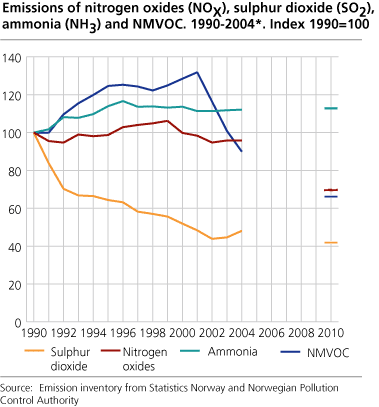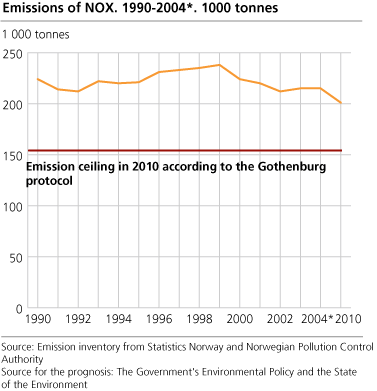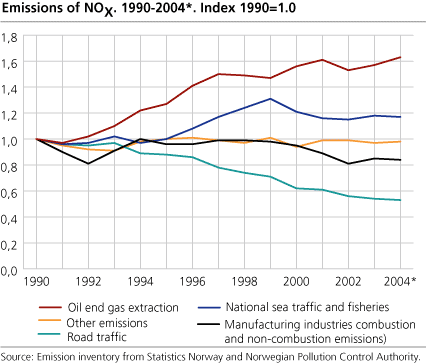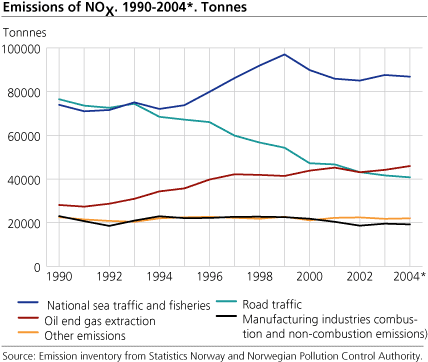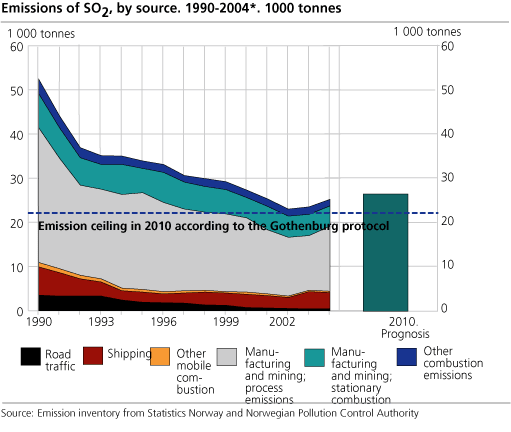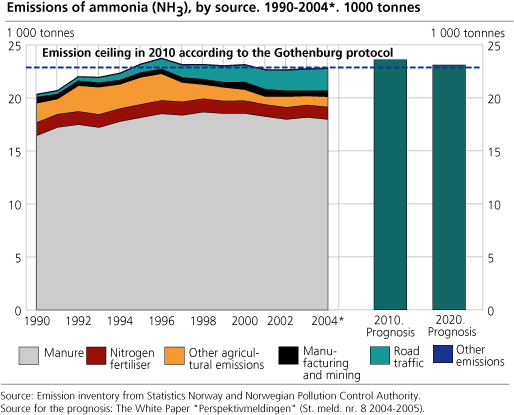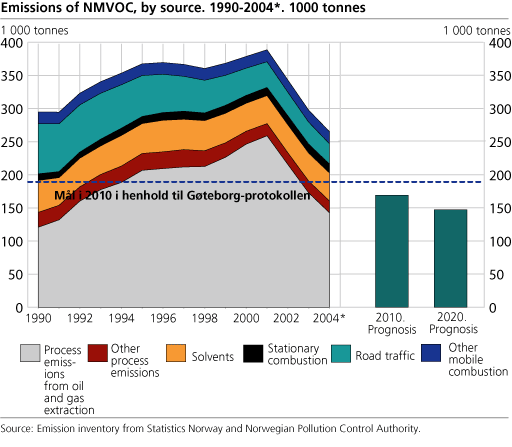Content
Published:
This is an archived release.
Norway far from nitrogen target
Norway has through the Gothenburg Protocol undertaken to reduce its emissions to air. For several gases, the target is within reach, but for nitrogen oxides and NMVOC, the emissions in 2004 were much higher than the 2010 target.
This is shown in new calculations from Statistics Norway and the Norwegian Pollution Control Authority.
Must reduce by 60 000 tonnes
The Norwegian emissions of nitrogen oxides (NOX) were in 2004 near 215 000 tonnes, almost exactly the same as in 2003. According to the Gothenburg Protocol, these emissions shall not exceed 156 000 tonnes by 2010. The reduction since 1990 has only been slightly more than 9 000 tonnes, and a further reduction of 60 000 tonnes will only be possible if strong measures are carried into effect.
In 1990, road traffic was the most important source of NOX emissions and accounted for 34 per cent of the total. In 2004, the share from road traffic was only 19 per cent, despite the growth in road traffic.The reduction is due to new restrictions on exhaust emissions from vehicles. However, emissions from light diesel vehicles are increasing.
Rise in emissions from oil and gas activities and from domestic shipping has put a brake on the reduction of the NOX emissions. In 2004, domestic shipping and fishing was the most important source, with 40 per cent of the NOX emissions, compared to 33 per cent in 1990. The emissions from gas turbines for electricity production on offshore installations rose from 8 per cent in 1990 to 16 per cent in 2004.
|
Emission ceiling 2010 according to the Gothenburg Protocol. Status 2004 and projections 2010.
Tonnes (per cent) |
| Component | Emissions 1990 | Emissions 2004 | Emission ceiling 2010 | Prognosis 2010 | Necessary reduction 2003-2010 | ||||||||||||||||||||||||||||||||||
|---|---|---|---|---|---|---|---|---|---|---|---|---|---|---|---|---|---|---|---|---|---|---|---|---|---|---|---|---|---|---|---|---|---|---|---|---|---|---|---|
| Nitrogen Oxides (NOX) | 224 130 | 214 767 | 156 000 | 200 800 | 59 000 tonnes (27 per cent) | ||||||||||||||||||||||||||||||||||
| Sulphur dioxide (SO2) | 52 505 | 25 251 | 22 000 | 26 900 | 3 000 tonnes (13 per cent) | ||||||||||||||||||||||||||||||||||
| NMVOC | 294 810 | 265 194 | 195 000 | 168 800 | 70 000 tonnes (26 per cent) | ||||||||||||||||||||||||||||||||||
| Ammonia (NH3) | 20 375 | 22 842 | 23 000 | 23 600 |
Emission ceiling reached at
the moment |
||||||||||||||||||||||||||||||||||
|
Source:
Emission inventory from Statistics Norway and Norwegian Pollution Control Authority.
Source for the projections: The White Paper "Perspektivmeldingen" (Report No. 8 (2004-2005) to the Storting. |
Sulphur dioxide is increasing
In the period from 1987 to 2002, the SO2 emissions were decreasing each year and were in 2002 1000 tonnes above the 2010-target of 22 000 tonnes (obligation according to the Gothenburg Protocol). After 2002, however, the emissions have increased by more than 2000 tonnes, passing 25 000 tonnes in 2004. The growth mainly took place in different manufacturing industries and in domestic shipping and fishing.
One of the reasons why it is more difficult than before to fulfill the SO2-obligation, is that emissions from Russian activity at Svalbard have been included in the Norwegian emission inventories. Furthermore, changes in the sulphur content of different fuel types have led to increased emissions of SO2 from shipping and fishing the last years.
SO2 emissions are nearly halved since 1990. The decrease is a result of cleansing of emissions from manufacturing industries, change from use of fossil fuels to use of electricity, or fuels and raw materials with lower sulphur emissions or lower content of sulphur.
Ammonia still below the target
Norway's emissions of ammonia (NH3) were in 2004 almost unchanged from the previous year and lay just below the target of 23 000 tonnes in the Gothenburg Protocol. Agriculture - especially livestock manure - accounted for 88 per cent of these emissions in 2004, 9 per cent came from petrol cars, while process emissions from manufacturing industries made up 2 per cent of the total.
NMVOCs down by 32 000 tonnes
The emissions of NMVOCs (Non-Methane Volatile Organic Compounds) must be considerably reduced in the years up to 2010. In 2004, these emissions totalled 265 000 tonnes, a decrease of 32 000 tonnes from the year before. A further reduction of 70 000 tonnes must be carried out to meet the commitments under the Gothenburg Protocol, 195 000 tonnes.
Evaporation during loading and storing of crude oil offshore is the main source of emissions of NMVOCs, and 46 per cent of the total in 2004 came from this source. However, these emissions have almost been halved since the peak year in 2001. Lower oil production has contributed to the reduction in the emissions. Measures that shall be carried out by the end of 2007, will ensure that 95 per cent of the crude oil will be loaded by use of technology that reduces the NMVOC emissions.
Emissions of NMVOCs from other sources have also been reduced during the last years. Loading at facilities with VOC recovery plants at onshore terminals, decreased sales of petrol and increased number of cars with catalytic convertors contributed to reduced NMVOC emissions in 2004. This trend has been going on for several years.
Projections
The latest projections for the national emissions are presented in the government's Report No. 8 (2004-2005) to the Storting (Perspektivmeldingen). In these projections, the NOX emissions will end up around 200 000 tonnes, which is about 45 000 tonnes more than the target in the Gothenburg Protocol. The projections for NMVOCs and ammonia indicate that these emissions will end up approximately on their respective targets, or they may be lower. For SO2 the projections are higher, but an agreement made with the Federation of Norwegian Industries will ensure necessary reductions to fulfill the obligations. There are considerable uncertainties connected to the projections.
Documentation of the Norwegian emission inventory
Statistics Norway has recently published a documentation of the methodologies for estimating emissions in the Norwegian emission inventory. The report, which describes methods, use of activity data, data sources and emission factors is used as a basis in Norway's annual emission reports to the United Nation Framework Convention on Climate Change (UNFCCC) and United Nations Economic Commition for Europe(UNECE). The report can be downloaded here .
Other articles published today
New calculations gave lower emissions (9.2.2006)
Small changes in heavy metals emissions (9.2.2006)
More figures in StatBank .
Tables:
The statistics is published with Emissions to air.
Contact
-
Statistics Norway's Information Centre
E-mail: informasjon@ssb.no
tel.: (+47) 21 09 46 42

